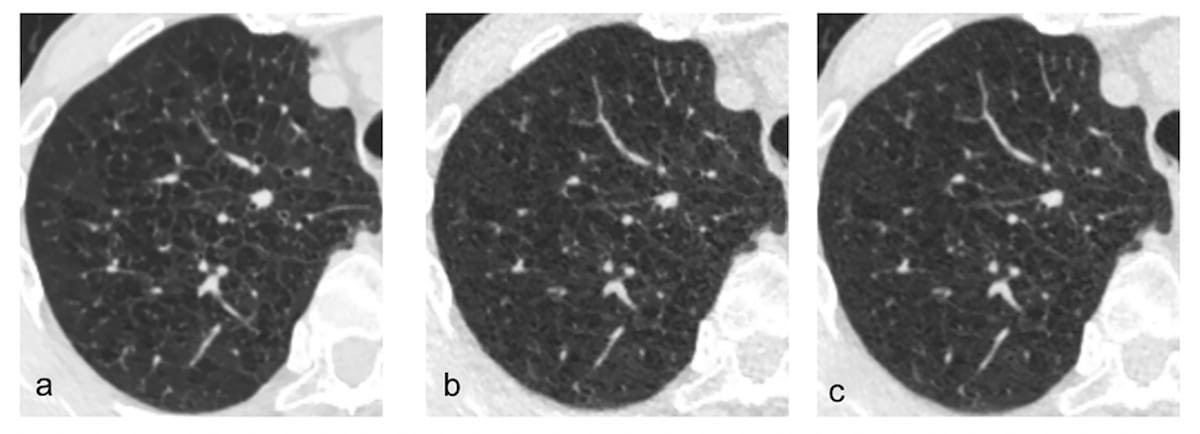Emerging research suggests that employing deep learning image reconstruction (DLIR) with ultra-low-dose computed tomography (ULDCT) may enable radiologists to reduce radiation dosing by nearly 93 percent for lung CT exams without sacrificing image quality.
For the study, published in Academic Radiology, researchers compared standard-dose computed tomography (SDCT) versus a combination of ULDCT and adaptive statistical iterative reconstruction-V 40% (ASIR-V 40%), and a combination of ULDCT and high-strength DLIR (DLIR-H) in 56 patients with suspected pulmonary nodules. The study authors noted that the radiation dose in both ULDCT groups was 0.25 +/- 0.08 mSv in comparison to 3.48 +/- 1.08 mSv for the SDCT cohort.
For solid, subsolid and calcified lesions, the researchers found no statistically significant differences between the imaging groups for lesion length diameter and transverse diameter. While the study authors noted subsolid nodule volume decreases (of 10.9 percent for ULDCT/ASIR-V 40% and 7.2 percent for ULDCT/DLIR-H) and risk classification reductions (of 9.9 percent for ULDCT/ASIR-V 40% and 3.3 percent for ULDCT/DLIR-H) in comparison to SDCT/ASIR-V 40%, there was no statistical significance, according to the study.
“In our study, ground glass nodules accounted for 81.5 percent of subsolid nodules. The reduction of radiation dose is particularly important for follow-up of ground glass nodules, which grow more slowly than solid or partially solid nodules and require repeated CT examination,” wrote study co-author Qiuju Fan, M.D., who is affiliated with the Department of Radiology at the Affiliated Hospital of Shaanxi University of Chinese Medicine in Xianyang, China, and colleagues.
For subjective image quality scores, the researchers found that ULDCT/DLIR-H was similar to SDCT/ASIR-V 40 percent with both having higher scores than ULDCT/ASIR-V 40%. They also saw no statistically significant difference in image quality scoring among the three groups for calcified lesions.
“The results showed that the use of the DLIR-H algorithm significantly improved image quality in ultra-low-dose conditions over the conventional ASIR-V 40% algorithm and generated similar image quality detection efficiency and quantification of pulmonary nodules as the standard-dose ASIR-V 40% images with a 93% radiation dose saving,” wrote Fan and colleagues.
Three Key Takeaways
- Significant radiation dose reduction. The use of deep learning image reconstruction (DLIR) in conjunction with ultra-low-dose computed tomography (ULDCT) resulted in a 93 percent reduction in radiation dosing for lung CT exams compared to standard-dose computed tomography (SDCT).
- Comparable image quality. Despite the significant reduction in radiation dose, the study found no statistically significant differences in image quality between ULDCT with DLIR-H and SDCT with ASIR-V 40%. The DLIR-H algorithm demonstrated a capacity to improve image quality in ultra-low-dose conditions, ensuring that radiologists can maintain high-quality images while minimizing radiation exposure.
- Potential clinical applicability for follow-up of ground glass nodules. The research highlights the importance of radiation dose reduction, particularly in follow-up examinations of ground glass nodules. As these nodules require repeated CT examinations and tend to grow more slowly than solid or partially solid nodules, the use of ULDCT with DLIR-H could be particularly beneficial in this clinical context.
The study authors also pointed out that nodule density differences between ULDCT/ASIR-V 40% and SDCT/ASIR-V 40% (65.41% for solid nodules, 21.5 percent for calcified nodules and 1.1 percent for subsolid nodules) were higher than the nodule density differences between ULDCT/ DLIR-H and SDCT/ASIR-V 40% (29.6 percent for solid nodules, 16.5 percent for calcified nodules and 0.6 percent for subsolid nodules).
“The use of (the) DLIR-H algorithm reduced the CAD density measurement errors compared to the standard-dose (ASIR-V 40%) algorithm under the condition of ultra-low dose,” added Fan and colleagues.
(Editor’s note: For related content, see “FDA Clears AI Software for Lung CT,” “FDA Clears AI-Powered CT Assessment Tool for Lung Fibrosis” and “Filters and Spectral Shaping: Pillars of Quality in Computed Tomography.”)
In addition to a small sample size, the authors acknowledged the lack of subgroup analysis as per BMI or lesion size. They noted a lack of manual adjustment for the automated segmentation of pulmonary nodules. The researchers also conceded possible bias with the pulmonary nodule analysis software in this study being training on conventional CT dosing as opposed to low-dose CT.
